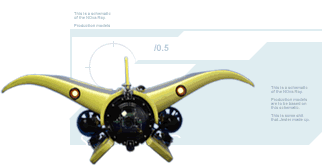Why Arcuate Wings are Important to the Nova Ray® Design
The Nova Ray® arcuate wing design solves long-time
industry struggles with cable drag in strong currents. The
patented wing design eliminates the phenomenon known as
"Dutch Roll Instability," a problem experienced
by flat wing designs. Anyone who has flown an old fashioned
kite and watched it roll side-to-side has experienced this
phenomenon.  The
Nova Ray® inventors eliminated "Dutch Roll"
by incorporating the "arcuate" form wing with
a rudder. The result is true axis flight and stability in
currents. The
Nova Ray® inventors eliminated "Dutch Roll"
by incorporating the "arcuate" form wing with
a rudder. The result is true axis flight and stability in
currents.
The arcuate-shaped wings of the Nova Ray® counteract
the lifting force of the umbilical (also described at the
tether or cable). Therefore, the speed of the boat (or other
vessel) or current has little effect on the operational
stability of the Nova Ray®. The wings increase cable
use efficiency and reduce the amount of cable necessary
to operate or tow at depth.
The physical dynamics of the arcuate (bow-shaped) wing
creates a stable instrumentation platform and allows for
maneuverability. This increases system effectiveness in
high currents and cross currents when towed or using thruster
power.
The Nova Ray's® unique hydrodynamic features effectively
use water flow rather than resistance to maintain operational
control under changing operating modes. The patented arcuate
wing is stable under tow or with the vehicle's own thruster
power.
Under thruster power, the wings operate just as a high-winged
airplane would in free flight. Under tow, the arcuate wing,
combined with the seamless shift in the center of rotation
from the cable pull, produces a stable configuration.
The challenge with towing any device is maintaining reasonable
control. Traditionally, underwater towable vehicles (UTV)
and the "box like ROVs" use frames layered with
flotation foam. Thrusters are then added to an already non-hydrodynamic
design in order to combat currents and other hydrodynamic
forces.
Nova Ray's® arcuate wing configuration is remarkably
stable in turbulent currents and provides true axis flight.
There is little tendency for the vehicle to rock in shifting
currents. The wings, combined with other secondary control
surfaces, tend to counter any destabilizing forces. The
close proximity of the thrusters to the control surfaces
allows for very tight maneuvering. The overall result is
an ROV system that can do more and perform where other underwater
systems cannot.
|

